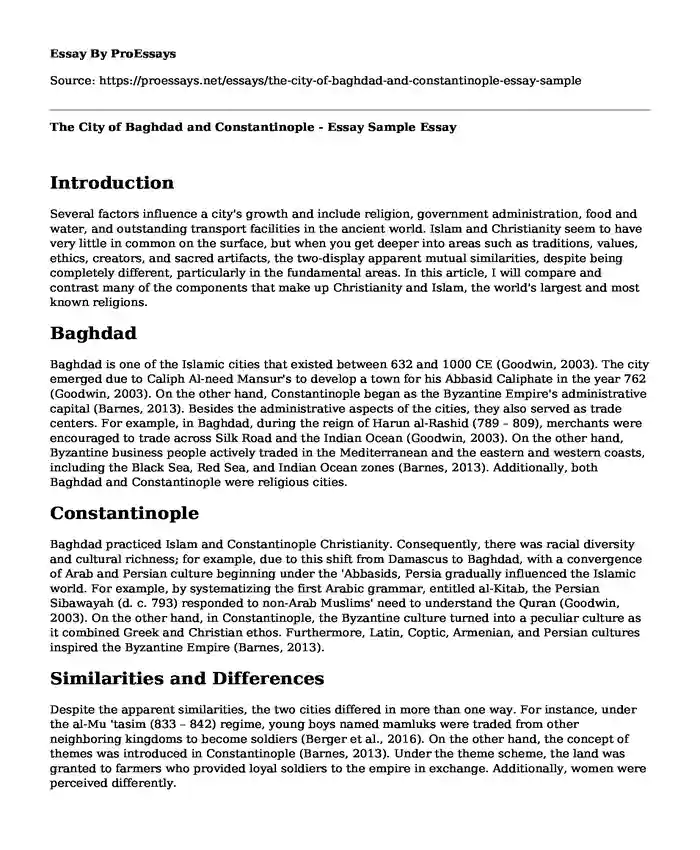Introduction
Several factors influence a city's growth and include religion, government administration, food and water, and outstanding transport facilities in the ancient world. Islam and Christianity seem to have very little in common on the surface, but when you get deeper into areas such as traditions, values, ethics, creators, and sacred artifacts, the two-display apparent mutual similarities, despite being completely different, particularly in the fundamental areas. In this article, I will compare and contrast many of the components that make up Christianity and Islam, the world's largest and most known religions.
Baghdad
Baghdad is one of the Islamic cities that existed between 632 and 1000 CE (Goodwin, 2003). The city emerged due to Caliph Al-need Mansur's to develop a town for his Abbasid Caliphate in the year 762 (Goodwin, 2003). On the other hand, Constantinople began as the Byzantine Empire's administrative capital (Barnes, 2013). Besides the administrative aspects of the cities, they also served as trade centers. For example, in Baghdad, during the reign of Harun al-Rashid (789 – 809), merchants were encouraged to trade across Silk Road and the Indian Ocean (Goodwin, 2003). On the other hand, Byzantine business people actively traded in the Mediterranean and the eastern and western coasts, including the Black Sea, Red Sea, and Indian Ocean zones (Barnes, 2013). Additionally, both Baghdad and Constantinople were religious cities.
Constantinople
Baghdad practiced Islam and Constantinople Christianity. Consequently, there was racial diversity and cultural richness; for example, due to this shift from Damascus to Baghdad, with a convergence of Arab and Persian culture beginning under the 'Abbasids, Persia gradually influenced the Islamic world. For example, by systematizing the first Arabic grammar, entitled al-Kitab, the Persian Sibawayah (d. c. 793) responded to non-Arab Muslims' need to understand the Quran (Goodwin, 2003). On the other hand, in Constantinople, the Byzantine culture turned into a peculiar culture as it combined Greek and Christian ethos. Furthermore, Latin, Coptic, Armenian, and Persian cultures inspired the Byzantine Empire (Barnes, 2013).
Similarities and Differences
Despite the apparent similarities, the two cities differed in more than one way. For instance, under the al-Mu 'tasim (833 – 842) regime, young boys named mamluks were traded from other neighboring kingdoms to become soldiers (Berger et al., 2016). On the other hand, the concept of themes was introduced in Constantinople (Barnes, 2013). Under the theme scheme, the land was granted to farmers who provided loyal soldiers to the empire in exchange. Additionally, women were perceived differently.
In Baghdad, Women were given power by Harem, and they played an essential role in influencing 'Abbasid politics, particularly in terms of succession issues. In Constantinople, women's cultural attitudes dictated that they should be confined in segregated spaces and stop being open-minded (Berger et al., 2016). They had their own spaces called gynaikonitis. However, women were considered a vital unit in the family, and attributes such as chastity were greatly encouraged, which was not the case in Baghdad as the apparent heir's mother was the second most influential woman in the household. She could be any woman, even a concubine, because when the Harem became more critical under the 'Abbasids, young attractive women were highly sought after.
Conclusion
From the study, I have eliminated prejudice and pre-judgment of different cultures. I am convinced that culture essentially influences some facets of an individual's life, if not close to all. Because varying cultures perceive other varying cultures with different condemnation levels, in conclusion, observing and learning how mental categories have changed encourages us to think about how our communities and environments will develop and ask ourselves what we can do to influence the process individuals.
References
Barnes, T. D. (2013). Constantine: dynasty, religion and power in the later Roman Empire (Vol. 16). John Wiley & Sons
Berger, E., Israel, G. L., Miller, C., Parkinson, B., Reeves, A., & Williams, N. (2016). World History: Cultures, States, and Societies to 1500. University of North Georgia Press
Goodwin, J. (2003). The glory that was Baghdad. The Wilson Quarterly (1976-), 27(2), 24-28.
Cite this page
The City of Baghdad and Constantinople - Essay Sample. (2024, Jan 10). Retrieved from https://proessays.net/essays/the-city-of-baghdad-and-constantinople-essay-sample
If you are the original author of this essay and no longer wish to have it published on the ProEssays website, please click below to request its removal:
- How Buddhist Beliefs Influence Attitudes Towards the Chandalas - Essay Sample
- Book Analysis Essay on Narrative of the Life of Fredrick Douglas
- Essay on Edward Snowden: Hero for National Security & Fair Treatment of World Citizens
- Essay Example on Hitler and Nazis: Racist Worldview and Anti-Semitism
- Essay on Dorothy Dandridge: Pioneering Black Actress, Singer, Dancer in Face of Racism
- Essay Example on Plato: Father of Western Philosophy & Redefining Virtues
- Essay Sample on British Colonization of the Americas: Challenges and Success







